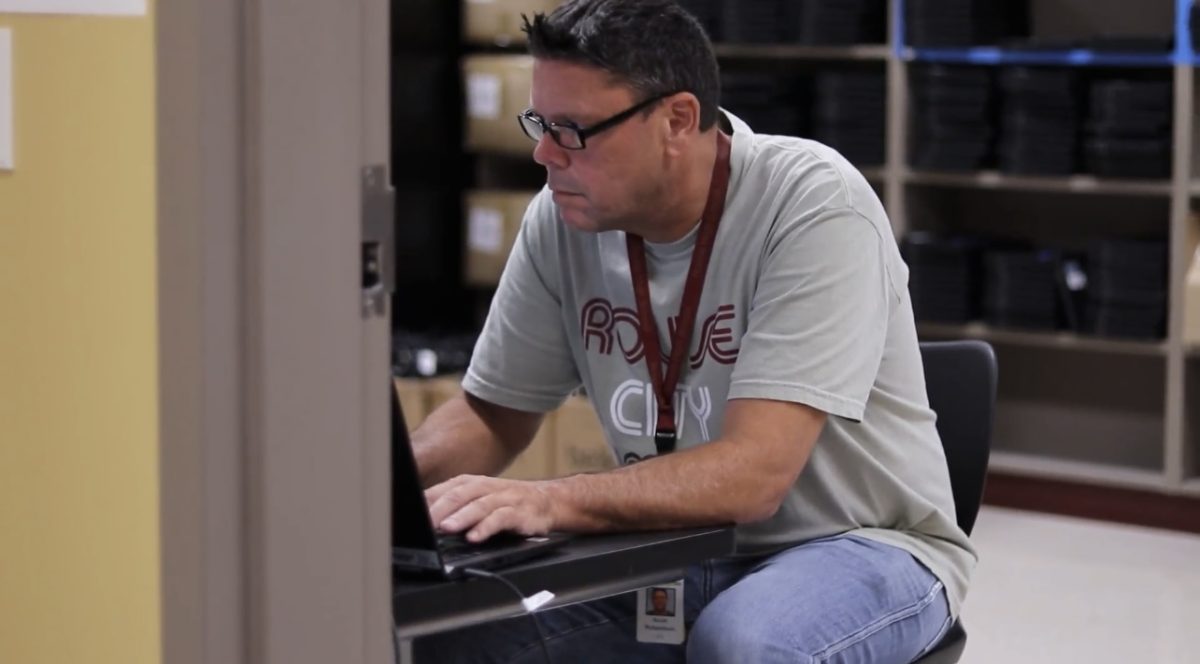*As seen in print
This year, classrooms look different than ever before. Each room features a brand-new Newline Multi-Touch Display screen, new computer models sit on many of the underclassmen’s desks, and informational posters about the School Day SAT and Advanced Placement exam registration now feature a brand-new phrase: “digital exams.”
Over the last few years, technology use has steadily increased across the district. Physical textbooks are a thing of the past as teachers begin to assign work with e-books, calculators and interactive simulations.
“My heart’s with the teachers,” campus technologist Scott Robertson said. “Whatever works for them to get the students to learn the best is good, and it’s not always on a computer. It’s just really up to the teacher and how they can connect with their students in the best way, and I would leave it to the teacher’s discretion.”
The districtwide decision to add Newline touch screens to classrooms came after Bond 2021’s Proposition B was passed with funds for the devices. In May 2023, the funds for installation were approved as well, and the screens were debuted across the district at the end of the 2023-24 school year. Despite the total cost of over $30 million, the project will help alleviate Robertson’s responsibility of replacing projector light bulbs and streamline classroom technology overall.
“My workload has gotten to where I would take any kind of help that I can get, because I’m supporting over 2000 students and over 200 staff,” Robertson said. “The [Newline staff] trained our teachers and technology staff, and they’re knowledgeable. It’s been a huge project, more than anyone can handle, but it’s starting to come together.”
AP Precalculus and AP Calculus AB teacher Weslee Copeland, who now strives to include technology in his lesson plans, can recall his own educational experiences before the rise of such devices and applications.
“I remember when I was in school, and we would ask the teacher, ‘Why can’t we use a calculator?’” Copeland said. “They would tell us, ‘It’s not like you’re gonna be walking around with a calculator in your pocket,’ which is so funny, because that’s what we have these days. Since we do have this technology, we need to be able to incorporate it and utilize it efficiently.”
High school students today, on the other hand, have been using technology in the classroom since they were very young. For reference the majority of the senior class are members of Gen Z, born in 2006 or 2007. The iPhone was invented in June 2007 when they were still infants. The oldest members of Gen Alpha were born in 2010 and entered high school as freshmen this year. Those students were born the same year Instagram and the iPad first launched.
“It’s better to have exposure to things that will be changing the world earlier, so you can get used to it, and when it does come around, then you won’t be lagging behind,” freshman Satvik Shukla said. “If you’re going to be introducing technology into certain subjects, then you should have it completely introduced in everything.”
Technology typically refers to physical devices rather than specific applications or practices. The Leander Mobile Learning Initiative, also commonly referred to as mLISD, is the program through which the district provides middle and high school students with a district-owned laptop. Starting with the class of 2027, the mLISD program switched the school laptops from Lenovo ThinkPad 11E model to the Lenovo 13w Yoga Touchscreen Notebook model.
“I’m excited about the mLISD program because that’s my biggest thing, is making sure that every student has the opportunity to have a computer,” Robertson said. “If they don’t, I want to make sure of what I can do to get it in their hands. I’m not saying that everyone needs to be on a computer, because that’s not really how we grow and learn, but it’s a helpful tool.”
Testing, in particular, has been revolutionized by the rise in educational technologies. The SAT transitioned to a digital format at the end of 2023, and CollegeBoard announced in July that 28 AP exams were officially moving to an online format as well. According to the not-for-profit organization, this was done to “preserve the integrity of the AP Exam experience” after a recent “rise in bad actors compromising AP Exam content for financial gain.”
“I knew it was coming,” Copeland said. “Over the past couple of years, they’ve been talking about it coming, but the College Board made a last minute decision to push it out much sooner. I was a little bit shocked because I knew I had to start thinking about this eventually, but now I’ve got to start thinking about it right now.”
It isn’t apparent yet how the effects of this kind of technology in education will affect the workforce and adulting norms of the future. As of right now, there seem to be both pros and cons.
“Sometimes the digital and technology stuff can lead to distractions, but other times, when it works really well and it increases engagement because it’s relevant to what students are encountering in their day-to-day lives,” Copeland said. “I try to teach more on that side of it.”


